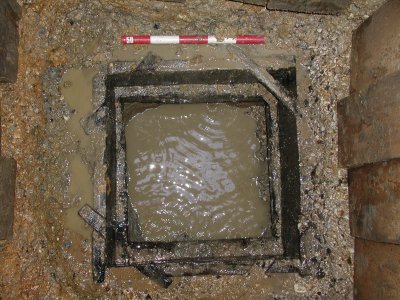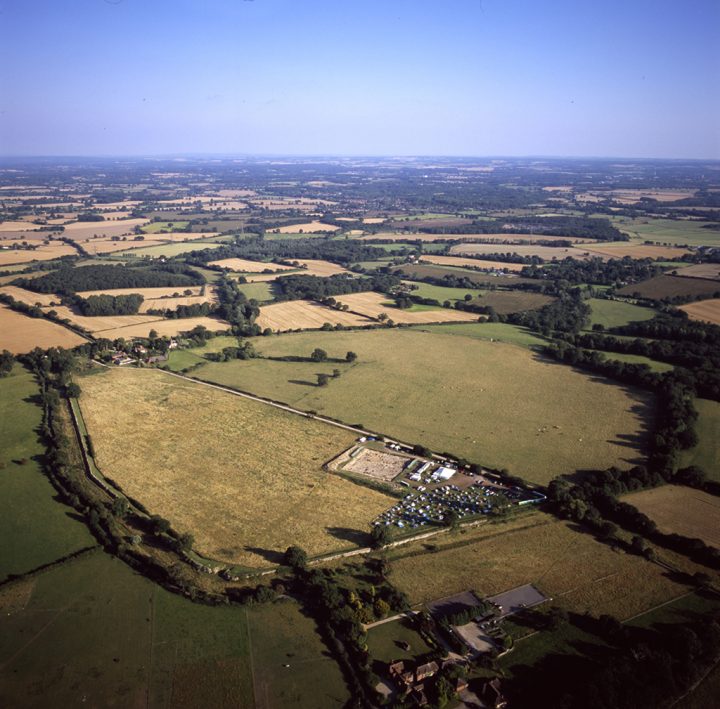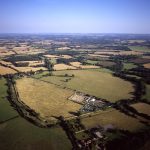Insula IX analysis
Pottery
Pottery is one of the most abundant finds on Roman sites. Jane Timby identifies our pottery and this helps date the features on site and, from the distribution of different types of pot (eg tableware, cooking or storage vessels), gives a clue to activities taking place in different rooms. Pottery can also tell us about trade links between Silchester and other parts of the Roman Empire. In several cases whole pots were deposited in wells as a ritual act. Sometimes these were deliberately pierced. Whole pots were also buried in two different corners of one of the rooms in House 1.

Studying timber
Wood does not normally survive on archaeological sites, but can be preserved in arid or waterlogged conditions. Dan Miles has looked at timbers used to line wells, like this one in the photo, cut deep into the gravelly soil. Timber can be used for dating (dendrochronology and radiocarbon dating) but also tells us about woodworking and construction techniques.

Evidence of Metal Working
Analysis of soil samples by Adam Wojcik has detected globules of gold. One sample was associated with a cupellation hearth in House 1. Cupellation is a metal working process whereby scrap gold and silver can be purified or silver extracted from native lead and it would have been common practice in the Roman period
Environmental Evidence from Soil Samples
Many of the pits and wells in Silchester also contain plant and insect remains, pollen and fish bones which are retrieved from soil samples. These add to our understanding of the diet of the people of Silchester. Dr. Mark Robinson, our environmental specialist, has found exotic plants such as walnuts and figs, indicating high status occupation.
Karen Wicks is working on pollen analysis which can show what plants were growing in the area, indicating the presence of gardens or derelict and weed infested open land.
CBM
Tiles often show foot and hand prints of both humans and animals, made when the tile was laid out to dry.
Ceramic building material is common in Silchester. Dr Sara Machin records and studies the frequency with which different types of tile (such as the flat tegula or the curved imbrex tiles) occur. The discovery of roof tiles indicates that a substantial building with a well-built roof was located nearby and analysis can reveal whether concentrations represent a destruction event or the gradual reuse, dispersal and residual occurrence of older material.

Animal remains
Hilary Snelling is an osteoarchaeologist who reports on the small amount of human bone we find. She has a special interest in human neonate bones (new born infants) and has analysed remains from pits in Insula IX
The bones and teeth of animals found in Silchester can tell us about the diet of the inhabitants. By ageing and sexing the remains, our specialist, Claire Ingrem, can also analyse Romano-British husbandry practices and establish whether animals were kept for their milk, wool or meat. Most of the animal bones recovered come from cattle, sheep and pig but we have also excavated a number of complete dog skeletons which have been examined by Dr. Kate Clark. Although often badly treated in life, these dogs may have been placed into pits for ritual reasons.

Small finds

Dr. Hella Eckardt is interested in how the computer database can be used to link the finds to the excavated remains.
Our many iron objects are examined by David Richards.
A wooden spoon, jet and bone pins, a glass bead, a die and an arm from a clay figurine. Objects like these give a fascinating insight into the activities of daily life. Nina Crummy, our small finds specialist, looks at all the special finds found on site. She is particularly interested in developing well dated sequences for different objects and using the functions of the objects to interpret how land and buildings were used.
Recording and Publication
The excavation’s paper records are all entered onto the Integrated Archaeological Database (IADB). The written context records, context plans, finds, photographs and specialist reports are all entered on site. The programme can be searched for linked records and can also draw matrices – diagrams of the how the different features on site link together.
Alongside more conventional publications such as interim reports, journal articles and popular articles, we are aiming to break new ground by publishing the site in digital format online. This exciting initiative is already under way using the data from the Antiquaries’ excavations, with summary interpretations linked to the live database.
Bibliography
 Clarke, A. and Fulford, M. 1997. Silchester Insula IX: Interim Report 1. Department of Archaeology, University of Reading.
Clarke, A. and Fulford, M. 1997. Silchester Insula IX: Interim Report 1. Department of Archaeology, University of Reading.
Clarke, A. and Fulford, M. 1998. Silchester Insula IX: Interim Report 2.Department of Archaeology, University of Reading.
Clarke, A. and Fulford, M. 1999. Silchester Insula IX: Interim Report 3.Department of Archaeology, University of Reading.
Clarke, A. and Fulford, M. 1999. ‘Silchester and the end of Roman Towns’. Current Archaeology 161, 176-180
Clarke, A. and Fulford, M. 2000. Silchester Insula IX: Interim Report 4.Department of Archaeology, University of Reading.
Fulford, M., Handley, M. and Clarke, A. 2000: ‘An early date for Ogham: The Silchester Ogham Stone Rehabilitated’, Medieval Archaeology 44, 1-23
Clarke, A. and Fulford, M. 2002. ‘Silchester, a crowded late Roman city’. Current Archaeology177, 364-371
Clarke, A. and Fulford, M. 2002. ‘The Excavation of Insula IX, Silchester: the first five years of the ‘Town Life’ project’, 1997-2001 Britannia 33,
Fulford, M. and Clarke, A. 2002. ‘Victorian Excavation Methodology: The Society of Antiquaries at Silchester in 1893’. Antiquaries Journal 82
Clarke, A., Fulford, M., and Rains, R. ‘Nothing to Hide – Online Database Publication and the Silchester Town Life Project’ in Doerr, M. and Sarris A. (ed.), The Digitial Heritage of Archaeology; Computer Applications and Quantitative Methods in Archaeology, Proceedings of the 30th CAA Conference, 401-404
Cook, S.R., Fulford, M., Clarke, A., and Pearson, C. ‘Soil geochemical analyses as an indication of metal working at the excavation of a house in the Roman City at Silchester. J. Phys. IV France, 107, 2003, 319-321.
Clarke, A. and Fulford, M. 2003 Silchester Insula IX: Interim Report 5, Department of Archaeology, Univeristy of Reading.
Clarke, A. and Fulford,M., 2004 Silchester Insula IX: Interim Report 6, Department of Archaeology, University of Reading
Our Thanks
The project would not have been possible without the co-operation and support of-
- Hampshire County Council
- The University of Reading
- The Arts and Humanities Research Board
- AWE, Aldermaston
- Basingstoke Archaeological & Historical Society
- Basingstoke and Deane Borough Council
- The British Academy
- The Haverford Bequest
- Nick and Biddy West
- Oxford Archaeology
- The Roman Research Trust
- The Silchester Association



